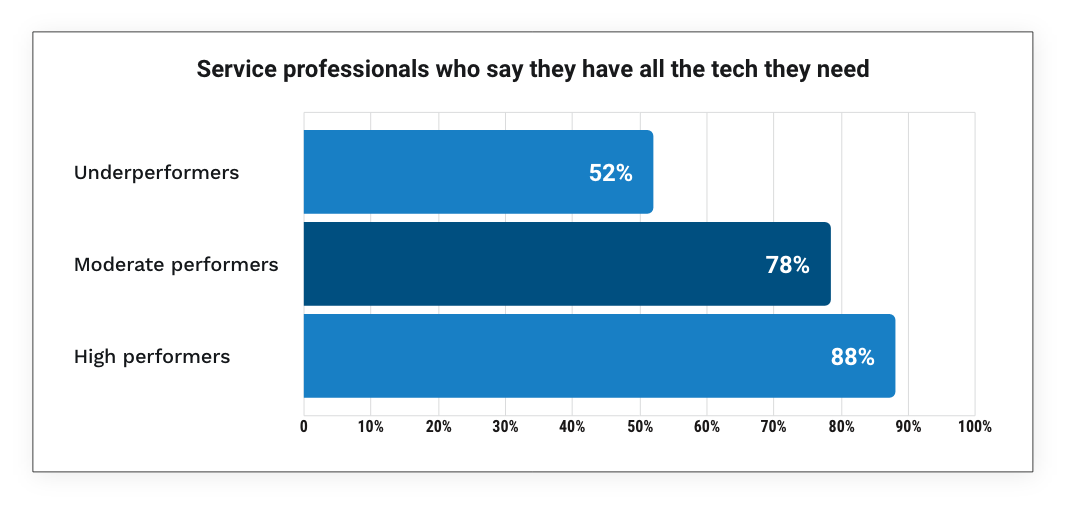
Get the Tech that Makes Customers Happy
Seventy percent of U.S. consumers believe that a company is only as good as its customer service. Seventy-seven percent will walk away if they receive poor service. Ninety percent would not shop with a retailer again if the retailer provides bad service.
It’s clear: To survive, you need to provide great service. And to provide great service – or at least keep up with your competitors – you need great technology. “Seventy percent of senior managers expect most routine customer interactions to increasingly be automated or handled through digital channels,” says Jo Causon, CEO of The Institute of Customer Service, a consultancy group. “Some organizations in our research said that 75-80% of their current customer interactions are already handled digitally.”
Most customer service technology falls into at least one of two categories: Tech that a customer can use without help and tech that requires customer service agents.
Self-service
Self-service tech isn’t an option; it’s a necessity. “Eighty-six percent of [customers] expect a self-service option, and two-thirds try self-service first before contacting a live agent,” says a 2020 survey by Microsoft. A 2021 survey by customer service expert Shep Hyken confirmed this finding: “Sixty-seven percent [of customers surveyed] said, ‘I use self-service tools.’ ”

Customers like working this way because “self-service gives control to the customer,” according to the Hyken survey. Even more important is speed. In an interview with Digital Mailroom, Kate Leggett – vice president and principal analyst at the advisory firm Forrester Research – said, “You want to have some type of self-service technologies to be able to give your customers quick answers to their questions.” Darren Prine, technology matchmaker at the agency Cloud Tech Gurus, agrees. “Customers expect self-service to be easy to use and allow them to resolve their own issues quickly,” he told DMR.
Self-service tech offers an advantage to companies, too: It costs less than human beings. “About five years or so ago, the rough approximate cost of just answering the telephone was around three and a half dollars when you account for salaries and building costs and everything else,” customer-service consultant Ian Golding, author of Customer What? The Honest and Practical Guide to Customer Experience, told DMR. “If we think how often are contact-center agents doing that unnecessarily, you know we are wasting billions. And it’s that unnecessary contact that I believe technology should be looking to deal with.”
What kind of unnecessary contact should self-service tech replace? “Customers are most receptive to AI and automation,” says The Institute of Customer Service’s Jo Causon, “when it is used to provide fast, accurate responses to enquiries, equip employees to give timely or better advice, or diagnose and resolve problems.” Robin Gareiss, CEO of the consultancy Metrigy Research, adds that self-service tech “can also conduct simple transactions or escalate interactions to a live agent.”
Of all the self-service tools, customer service experts most often recommend chatbots, especially the ones using artificial intelligence. “Service organizations have increased their adoption of chatbots — which are often powered by AI — by nearly two-thirds since 2018,” says a Salesforce report from December 2020.

If you want examples to follow, Business Insider, Influencer Marketing Hub, and other authorities recommend these chatbots:
- Dom at Domino’s Pizza
- Julie at Amtrak
- Sephora’s bot on the chat site Kik and its two bots on Facebook Messenger
- The World Health Organization’s bots on WhatsApp, Facebook Messenger, and elsewhere
Another popular self-service tool is an online knowledge base. “A good website – which most businesses, large and small, can easily afford – can include a frequently asked question knowledge base,” Shep Hyken told DMR. “It’s very inexpensive to put in there – and put an index in there so you can drop in different categories.”
Search Engine Journal, HubSpot, G2, and other experts say that you can find FAQs worth emulating at:
Many experts also suggest making videos. The most useful are often “video tutorials – even very inexpensive, for lack of a better term, homegrown-type videos – that … will teach the customers what they need” to know about your products, Hyken told DMR. Experts at HubSpot and other authorities recommend tutorials from:
We suggest that you also look at Digital Mailroom’s videos and our frequently asked questions.
The human factor
“Bots and self-service options are beneficial for handling simple transactions,” says a survey of 11,000 consumers by the customer-software firm Genesys, “[but] a human customer service representative is preferred when there’s an issue with a product or when a customer needs additional information.”
MIT Technology Review explains, “Think of a tourist explaining a problem in a second language, or someone struggling to follow assembly instructions for a ceiling fan. In these scenarios, empathy is critical. A human has to be in the loop to work with the customer directly.”

Genesys’s survey uncovered eight “top issues where a human rep is most desired”:
- Physical problem with a product or service
- Inaccurate billing
- Technical (software, digital, or online) issues
- Product replacement or return
- Delayed package or delivery problem
- Confusing benefits or account features
- Internet outage
- Reservation or booking problem
Fixing these problems requires agents and technology. Agents who use the right tech are likely to be very effective, as the chart below demonstrates.

For an example of tech that agents need, look at the problem that angers 84% of consumers in one survey and ranks as the top customer-service complaint in another: Having to repeat information. Business-tech journalist Phillip Britt explains, “Customer service interactions [often] start on the web, then shift to email, and then involve a phone call that gets interrupted, prompting the customer to return to one of the previous channels or another altogether.” Customers may have to restate their problem every time.

The right software can minimize or eliminate this problem. Roy Atkinson, CEO of customer-experience consultancy Clifton Butterfield, told DMR his advice for any business: “Your company should have some form of customer relationship management (CRM) software, a central record of all the interactions you have with customers.” Atkinson added that the job requires specialized software: “Excel spreadsheets don’t cut it for this.”
Some of the best software products, according to sites such as TechRadar, Business News Daily, Software Testing Help, and PC Magazine, are:
Giving agents information is just a start, though. “It’s really important that you need to give [customers] easy access to a human being,” Shep Hyken told DMR.
In particular, said Darren Prine, “they expect vendors to meet them on the digital channel (or voice) of their choosing.” Surveys by management consulting firm The Northridge Group, software advisory company GetApp, call-center tech firm TCN, and customer satisfaction measurement company CFI Group say that customers usually choose three channels above all others:
- Phone
- Live, online chat with an agent
But customer preferences can change, and tech developers are devising new and improved ways for customers to reach companies. That’s why many experts agree with Ian Golding, who says, “We need organizations to think about the omnichannel journey.”Lorem ipsum dolor sit amet, dicit euismod praesent id nam, eum iriurev civibus ponderum eu.
Reuben Yonatan, CEO of cloud communication advisory firm GetVoIP, explains, “Omnichannel customer service allows consumers to reach a company’s customer service team using a variety of methods … [and] provides a more personalized customer service experience because customers can reach out through their preferred communication channel.”
Omnichannel helps agents as well as consumers, Yonatan says. “With an omnichannel customer service solution, agents are able to see a streamlined customer and conversation history even if the customer chooses to use different channels at different times.”
Even old-fashioned paper mail has its place. Unfortunately, it’s slow – but a service like Digital Mailroom can speed it up by digitizing and indexing the mail for easy searching, and uploading it to a secure web portal. When customers need help, you can find their correspondence right away and solve their problems quickly.
The big picture
Customer service technology has so many varieties and complexities that it can distract you from why you need it. Adam Toporek, president of the consultancy CTS Service Solutions, put the key points into perspective in an interview with DMR. “It is crucial to imagine using the [tech] product in your organization. Assuming you’ve done your due diligence and you know that the product functions well overall, the real question is, will it function well for you? Will it mesh with your existing systems? Will there be a huge learning curve for employees? Will the experience be good, both for customers and employees? And most importantly, will it effectively facilitate your customer and employee experience goals?”
“The best technology to help a company serve customers,” Toporek added, “is the one that enables them to create a hassle-free customer journey that meets or exceeds customer expectations – and that also gives customer-facing teams the tools and information they need to facilitate this journey.”

